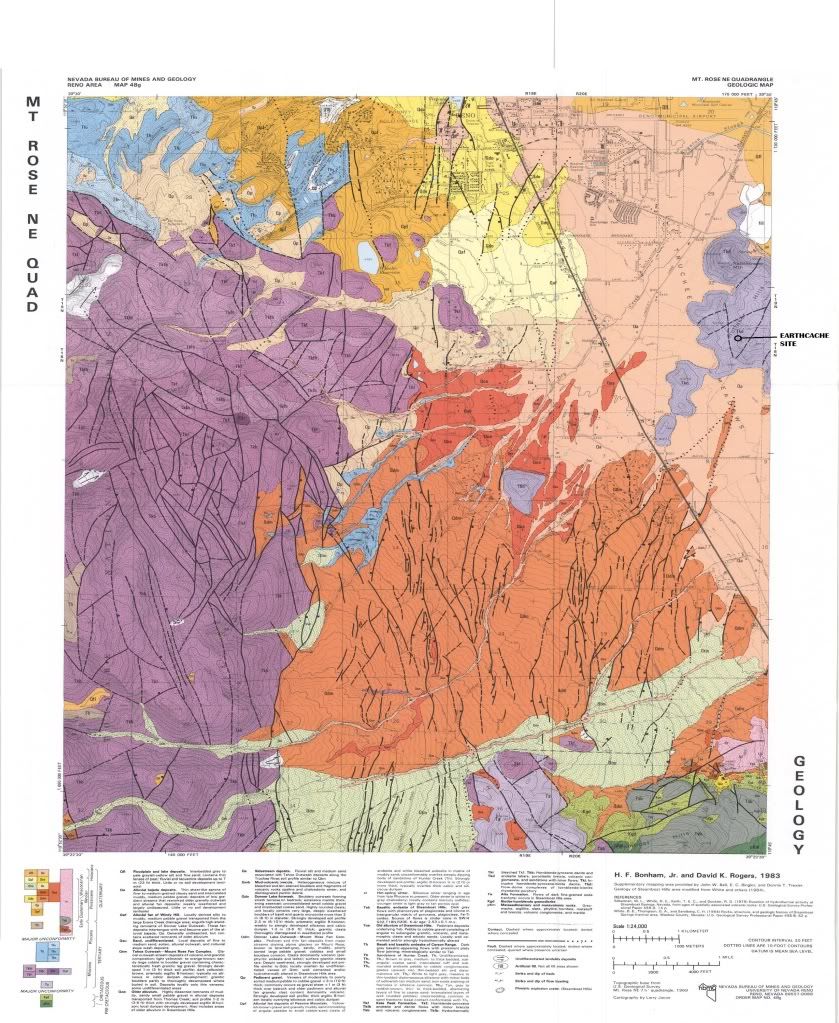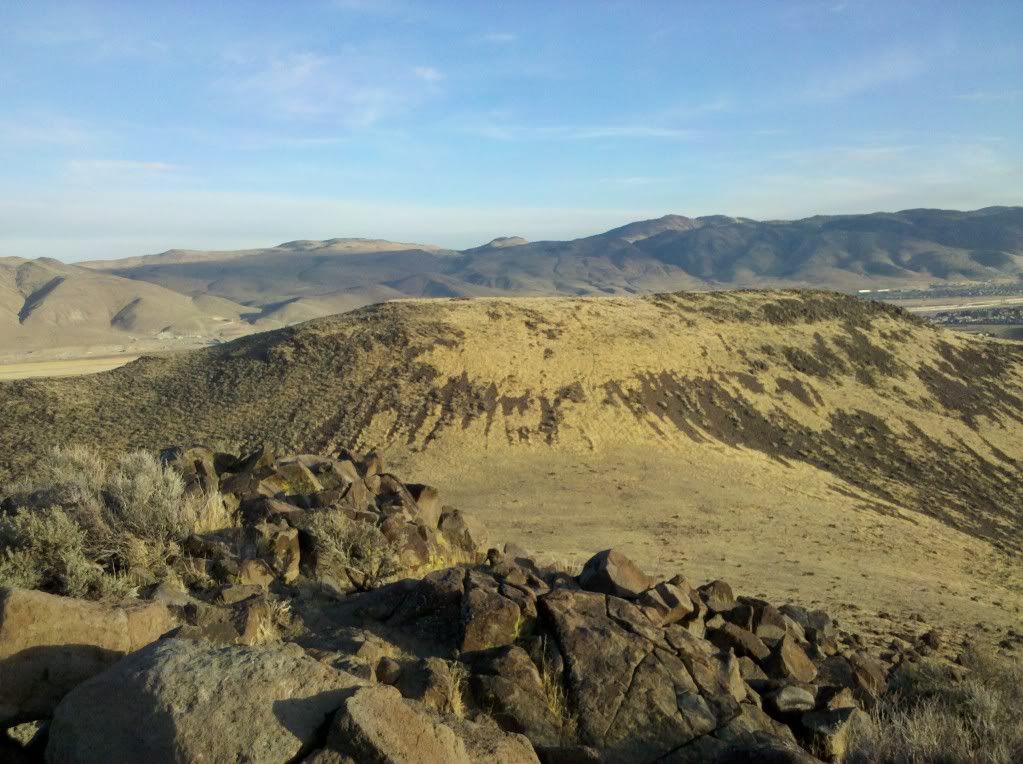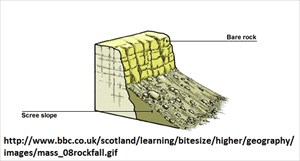HUFFAKER HILLS SCREE SLOPE EARTHCACHE
You can park in either parking area and it is not too far of a hike to the site.
It should be noted here that the formation of these hills is NOT the main focus of this site. The scree fields you are standing in the middle of and the pieces of rock that have formed them is the subject of this Earthcache. The information is provided to better your understanding of how scree fields are formed.
TO LOG THIS EARTHCACHE:
Read below, observe the scree field and answer the following questions. Send your responses to the developer of this site
- Given the shape and size of the fragments that make up the scree field, which type of erosion is/was responsible for forming it?
- Based on what you see at the summit above you, has the process of scree formation completely stopped altogether?
- What do you base your answer on?
- OPTIONAL: Post a photo of you and your group at this location on your log.
Geology:
A little background information on how these mountains were formed is helpful in understanding the formation of scree fields that are scattered all over them. There are 5 basic types of mountains:
- Fold Mountains (Folded Mountains)
- Fault-block Mountains (Block Mountains)
- Dome Mountains
- Volcanic Mountains
- Plateau Mountains
We will look at the two types that are relevant here:
The surrounding mountains of the Virginia Range are Block Mountains. They are formed when faults or cracks in the earth's crust force some materials or blocks of rock up and others down. The earth's crust breaks up into blocks and the blocks end up being stacked on top of each other. This process takes millions of years.(CITATION: Woodland Junior School)
Huffaker Hills, part of the Kate Range is volcanic. It is comprised of Rhyolitic lava erupted 8 to 25 million years ago from vents that opened up along the fault system that runs through here (CITATION: GEOLOGICAL SURVEY BULLETIN 1042-C, Geology of the Virginia City Quadrangle, Nevada by GEORGE A. THOMPSON).
This type of lava is characterized by it's high viscosity (resistance to flow) and low gas content. The result of this type of eruption would be lavas that do not flow away from the vent, but instead pile up over it. The surface of volcanic domes are generally very rough, with numerous spines that have been pushed up by the magma from below. If you look closely, you can see remnants of the spines that have eroded down in the time since these lava domes were formed. (CITATION: http://www.tulane.edu/~sanelson/geol204/volcan&magma.htm AND GEOLOGICAL SURVEY BULLETIN 1042-C, Geology of the Virginia City Quadrangle, Nevada by GEORGE A. THOMPSON).
The materials that make up this dome were thick and blocky. They erode, crack up and break off by the processes described below. As a result of the composition of this dome, the scree or talus is comprised of jagged rocks that vary in size and shape. This means that you are likely to see dark colored hard lenticular crystals of hornblende as well as some flaky brown biotite crystals in a fine grained matrix at this particular location.

Nevada Bureau of Mines and Geology MT. Rose NE Quadrangle Geologic Map
Scree or Talus is the result of geologic processes of erosion or weathering. Some examples are:
- Mechanical weathering by ice: Ice forms in cracks on the mountain slopes. The ice puts pressure on these cracks and breaks off pieces of rock that tumble down the slope and form fields of broken, jagged, various sized rocks.(CITATION:Wikipedia Article on scree)
- Chemical weathering by mineral hydration and salt deposition: Water from rain or snow melt reacts with minerals and chemicals in the rock which breaks it down in it's weakest spots first. The fragments then break loose and fall down the slope to form scree fields. The composition of the rocks would be chemically altered if this type of weathering were taking place. Examples of this type have shown that the rocks are more smooth or rounded than those that have been mechanically weathered. Also, This process can be sped up by mechanical weathering since the cracks that are opened up by ice or other factors can allow more minerals to enter and react with the rock.(CITATIONS: geology.about.com and Wikipedia Article on scree)
- Thermal stresses: Heated rock expands while cooled rock contracts. When these processes are sped up by large temperature swings, the resulting stress can break up the mountain slope in its weakest spots. The fragments then form the scree field. This type may be a small contributor at this spot. This process can also speed up chemical weathering. (CITATION:Wikipedia Article on scree)
The scree drains rapidly. The pieces break off in various sizes and tumble down the dome. As this happens, and the rocks settle, the smaller peices fall into the gaps formed by the way the larger pieces lie in the scree field. Eventually the scree production stops because the rock slope becomes completely covered or mantled in it's own scree. Another important fact is that scree fields typically have a concave upwards form. (CITATION: Wikipedia Article on scree)

Nearby scree fields
The diagram below illustrates a typical scree slope:

As you can see, as the upper portions of the peak continue to break apart and tumble down the slope, the peak shown will eventually be completely mantled in scree. Once this happens, can you see how not only will the elevation be lower, the shape of the peak will be altered? This is a prime example of how geology continues to shape and mold our planet! Can you imagine what Huffaker Hills must have looked like before they eroded and the scree fields were formed?
Special thanks to my friend Jim for his help in the research. Dan Erbes from the BLM for his technical assistance and The Washoe County Parks Department for their support of this cache.
REFERENCES:
Wikipedia article on scree
Woodlands Junior School article on types of mountains
bbc.com.uk Scree Diagram
About.com/Geology
www.tulane.edu
GEOLOGICAL SURVEY BULLETIN 1042-C, Geology of the Virginia City Quadrangle, Nevada by GEORGE A. THOMPSON
| I am a proud |
 |